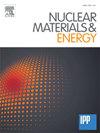Quantitative characterization of deuterium and helium retention in the marked tiles with various materials exposed to HL-2A tokamak
IF 2.7
2区 物理与天体物理
Q1 NUCLEAR SCIENCE & TECHNOLOGY
引用次数: 0
Abstract
The retention of hydrogen isotopes in the fusion device is critical due to safety concerns. In this work, the deuterium (D) and helium (He) retention features in the different marked tiles exposed to HL-2A tokamak discharge plasma were quantitatively characterized using long pulse laser induced desorption-quadrupole mass spectrometer (LID-QMS) combined with SEM and EDX. The D retention originates primarily from D plasma discharges of HL-2A during 2021 campaign, and the He retention comes primarily from the helium glow discharge cleaning (He-GDC). The marked tiles materials include pure bulk W, bulk stainless steel (S.S) and W-, C-, Fe-films deposited on titanium-zirconium-molybdenum alloy (TZM) or W substrates. The LID-QMS results indicate that the D and He retention distribution along the poloidal direction of HL-2A device exhibited an overall uniformity. The sequence of the D concentration trapped in the marked tiles is C-film > W-film > Fe-film/bulk S.S > bulk W, whereas the He retention is Fe-film > bulk S.S > W-film > bulk W > C-film. The D retention is higher than the He retention in all measured materials. And the D and He trapped in the film tiles are higher than those in bulk tiles. The probable reasons for the differences were discussed in combination with the changes of the surface micro-morphology and the elemental compositions of the marked tiles. This investigation would provide a reference for future in-situ application of LID-QMS to monitor the D and He retention in bulk tiles and deposited materials, and also gives the data support for fuel particle transport modelling.
HL-2A托卡马克辐照下不同材料标记瓦中氘和氦保留的定量表征
出于安全考虑,聚变装置中氢同位素的保留是至关重要的。利用长脉冲激光诱导解吸-四极杆质谱联用扫描电镜(SEM)和电子能谱仪(EDX)对HL-2A托卡马克放电等离子体辐照下不同标记瓦片中氘(D)和氦(He)的保留特征进行了定量分析。D滞留主要来自HL-2A在2021战役期间的D等离子体放电,He滞留主要来自氦辉光放电清洗(He- gdc)。标记的瓷砖材料包括纯块状W,块状不锈钢(S.S)和W-, C-, fe -薄膜沉积在钛锆钼合金(TZM)或W衬底上。LID-QMS结果表明,HL-2A器件沿极向方向的D和He保留分布总体均匀。标记瓷砖中捕获的D浓度顺序为c -膜>;W-film祝辞Fe-film/bulk s >;体W,而He保留为fe膜>;散装船>;W-film祝辞散装W >;C-film。在所有被测材料中,D保留率均高于He保留率。薄膜瓦片中的D和He含量高于散装瓦片。结合标记瓷砖表面微观形貌和元素组成的变化,探讨了造成差异的可能原因。该研究可为未来原位应用LID-QMS监测块状瓦片和沉积材料中D和He的保留提供参考,并为燃料颗粒输运建模提供数据支持。
本文章由计算机程序翻译,如有差异,请以英文原文为准。
求助全文
约1分钟内获得全文
求助全文
来源期刊

Nuclear Materials and Energy
Materials Science-Materials Science (miscellaneous)
CiteScore
3.70
自引率
15.40%
发文量
175
审稿时长
20 weeks
期刊介绍:
The open-access journal Nuclear Materials and Energy is devoted to the growing field of research for material application in the production of nuclear energy. Nuclear Materials and Energy publishes original research articles of up to 6 pages in length.
 求助内容:
求助内容: 应助结果提醒方式:
应助结果提醒方式:


